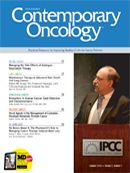Tasigna Moves to the Front-Line in CML
The FDA approved Tasigna (nilotinib) as a first-line treatment for patients with newly diagnosed Philadelphia- chromosome positive (Ph ) chronic myeloid leukemia (CML), the first new drug approved for this indication in nearly a decade.
The FDA approved Tasigna (nilotinib) as a first-line treatment for patients with newly diagnosed Philadelphia— chromosome positive (Ph ) chronic myeloid leukemia (CML), the first new drug approved for this indication in nearly a decade. The decision follows a priority review that primarily considered data from the ongoing ENESTnd (Evaluating Nilotinib Efficacy and Safety in Clinical Trials of Newly Diagnosed Ph CML Patients) study. According to 24-month data from the ENESTnd trial, nilotinib is
more effective and faster at inducing response than imatinib (Gleevec), the current gold standard for newly diagnosed CML.
For phase III of ENESTnd, an open-label, multicenter trial, researchers accrued 846 adult patients with previously untreated CML. Patients were randomized 1:1:1 to either 300 mg (n = 282) or 400 mg (n = 281) of nilotinib twice daily or 400 mg (n = 283) of imatinib once daily, with 5 years of follow-up. The primary outcome measure was the rate of 12-month major molecular response (MMR). The main secondary endpoint was the rate of cytogenetic response (CCyR) at 12 months. Researchers published 12-month data in the New England Journal of Medicine in June. At the 2010 American Society of Clinical Oncology meeting in
Chicago, Illinois, 18-month data were presented, along with 24-month data for a small subset of patients.
The 12-month MMR rates were 44% and 43% for the 300 mg and 400 mg nilotinib arms, respectively, nearly double the imatinib cohort’s 22% MMR rate. CCyR rates at 1 year were 80% and 78% in the 300 mg and 400 mg cohorts of nilotinib, respectively, compared with 65% for the imatinib arm. “Certainly nilotinib is a better drug than imatinib. I would like to start all patients on nilotinib therapy just to lower the risk of progression of disease that can occur in the first 2 to 3 years of therapy,” said lead investigator Giuseppe Saglio, MD. Both treatments were well tolerated at 12 months, with adverse events causing discontinuation for 5% of patients in the 300-mg nilotinib arm, 9% of patients in the 400-mg nilotinib arm, and 7% of patients in the imatinib arm. Patients receiving imatinib were more likely to experience gastrointestinal effects and edema, whereas the nilotinib cohorts had higher rates of dermatologic events and headache. Only 2 patients on nilotinib had disease progression to accelerated phase or blast crisis, compared with 17 patients treated with imatinib. No one in the study experienced sudden death related to treatment.
Nilotinib’s superior efficacy held up at 18 and 24 months. MMR rates at 18 months were 69% and 63% for the smaller and larger dose nilotinib cohorts, respectively, compared with 36% for the imatinib group. At 24 months, MMR rates in the 300 mg and 400 mg nilotinib arms were 86% and 88%, respectively, compared with 48% in the imatinib arm. From 12 to 18 months, the gap in CCyR rates between nilotinib and imatinib closed slightly, with 85% and 82% rates for the 300 mg and 400 mg nilotinib arms, respectively, versus 74% for the imatinib cohort (P <.001 and P = .017 for the two comparisons, respectively). The two treatments continued to be well tolerated at 18 months, with discontinuation rates of 7% for the 300 mg nilotinib group, 11% for the 400 mg nilotinib group, and 9% for the imatinib cohort. According to Saglio, the goal now is to “…achieve complete molecular remission and to have the possibility to discontinue the treatment…in the highest percentage of patients that we are treating.”




